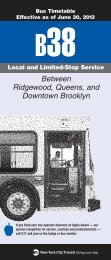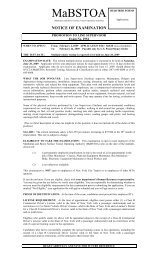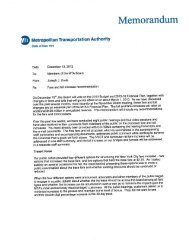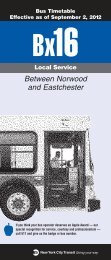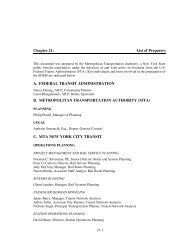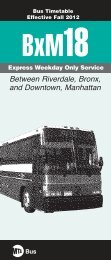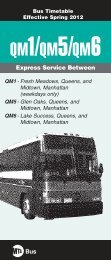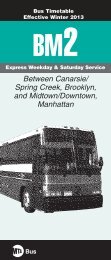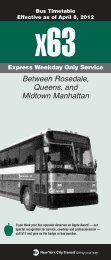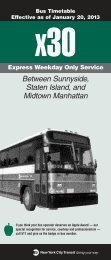Greening Mass Transit & Metro Regions: The Final Report - MTA
Greening Mass Transit & Metro Regions: The Final Report - MTA
Greening Mass Transit & Metro Regions: The Final Report - MTA
You also want an ePaper? Increase the reach of your titles
YUMPU automatically turns print PDFs into web optimized ePapers that Google loves.
66<br />
7. Provide incentives to developers who design and construct to LEED-Neighborhood Development (ND) Standards<br />
and achieve a Gold rating.<br />
LEED standards, including LEED-ND, do not adequately account for the greening effects of transit and should be modified<br />
to reflect the strong per-capita GHG reduction that transit generates.<br />
8. Modify and/or expand existing funding programs to increase funding for transit.<br />
• Based on the growing demand for transit and high ridership levels, more resources from Section 53072 and 53093 programs are needed for maintenance, routine replacement, and expansion projects. <strong>The</strong>se programs provide guaranteed<br />
funding for transit.<br />
• Congestion Mitigation Air Quality (CMAQ). <strong>The</strong> eligibility should be revised so that vehicle miles traveled (VMT) reduction<br />
is not the sole criterion. Certain types of transit projects should be automatically eligible for CMAQ if significant transit<br />
mode share is demonstrated. Public transit benefits air quality and should be eligible for any funds whose objective is to<br />
improve the environment.<br />
• Surface Transportation Program (STP). Additional funding for enhancement programs under STP could be used for bike,<br />
pedestrian, and transit station access improvements.<br />
9. Reform federal processes and procedures to advance the <strong>MTA</strong>’s federally-funded transit projects as expeditiously<br />
as possible.<br />
<strong>The</strong> Commission recognizes the importance and necessity of federal oversight, but in some cases, processes and procedures<br />
should be revised so that projects can advance as quickly as possible in order to provide sustainability benefits to the New<br />
York metropolitan region.<br />
• Expand the categorical exclusion list to include more transit projects. All federally funded projects are subject to the<br />
National Environmental Policy Act (NEPA), which requires project sponsors to consider the environmental impacts of their<br />
proposed actions. Categorical exclusions (CEs) are projects that, based on past experience, do not individually or cumulatively<br />
have significant environmental impacts. <strong>The</strong>se projects require neither an environmental assessment nor an environmental<br />
impact statement and can move ahead more quickly. <strong>The</strong> list should be expanded to include the rehabilitation of<br />
transit stations and other facilities that do not require additional property. This addition will align the list of categorically<br />
excluded transit projects with the list for highway projects, which includes improvements to existing rest areas and truck<br />
weigh stations, where no additional property is needed.<br />
• Develop single regulatory process for multi-modal projects. A single process for the Federal <strong>Transit</strong> Administration (FTA)<br />
and Federal Highway Administration (FHWA) to follow for multi-modal projects will allow for faster implementation of<br />
projects that provide connections between modes and highway projects that include a transit component. Better connections<br />
between modes will encourage transit use.<br />
• Make procedural changes to expedite grant awards for state-of-good-repair projects. Minor procedural adjustments<br />
would allow for more timely grant awards. FTA should not wait to begin reviewing grants online while required project<br />
documents (e.g., project management plans, force account plans) are being completed. <strong>The</strong>se documents can be reviewed<br />
on a parallel track. When a project is funded through multiple grants, FTA should allow grantee to refer to FTA Quarterly<br />
<strong>Report</strong>s and/or prior grants for basic project description information. Concurrent internal review of grants by FTA departments<br />
would allow for more timely grant approval. When grants are not approved in a timely manner, they must be updated<br />
continually and re-reviewed by FTA.<br />
• Make procedural changes to the New Starts/Small Starts project development process that would decrease approvalrelated<br />
delays. <strong>The</strong> FTA’s New Starts program provides discretionary funding for major capital investment transit projects,<br />
such as <strong>MTA</strong>’s Second Avenue Subway and East Side Access projects. <strong>The</strong> FTA has developed detailed eligibility criteria to<br />
ensure that only the most meritorious projects receive New Starts funding. Project information is reviewed and approved at<br />
several points during design before final funding commitment from the FTA is granted. Because the cost of delay is particularly<br />
acute for large-scale construction projects, the New Starts process should be adjusted so that work never has to come<br />
to a stop while a project awaits an FTA approval. <strong>The</strong> Commission is confident this can be done without compromising the<br />
FTA’s ability to ensure compliance. For example, a single joint (FTA/grantee) risk assessment could be conducted prior to<br />
project grant agreement, replacing multiple risk assessments at different points of design.<br />
2 Section 5307 makes federal resources available for transit capital investments to urbanized areas with population over 50,000.<br />
3 Section 5309 provides capital assistance for fixed guide way modernization, bus and bus facilities and major capital investments (New Starts/Small Starts).



